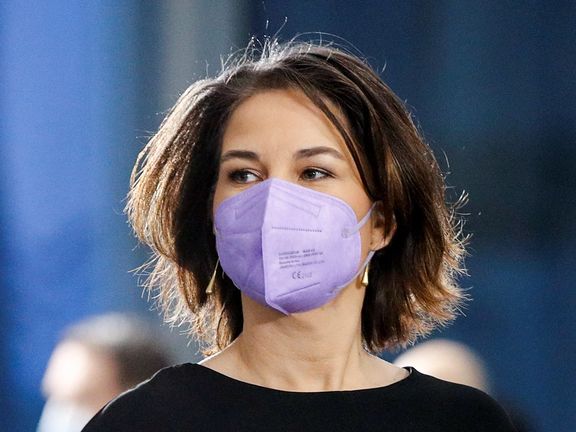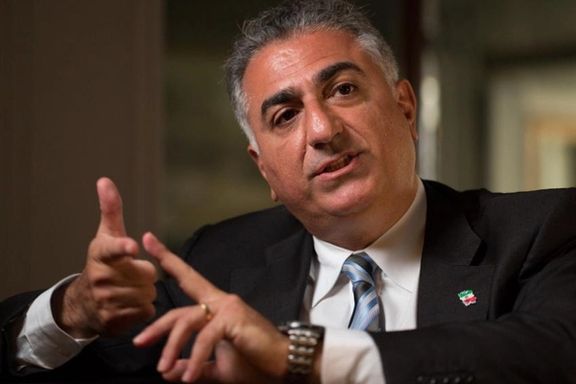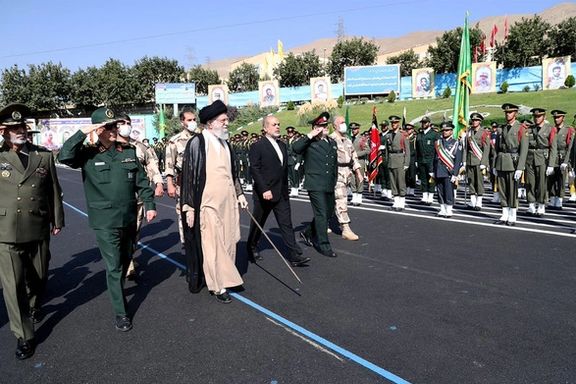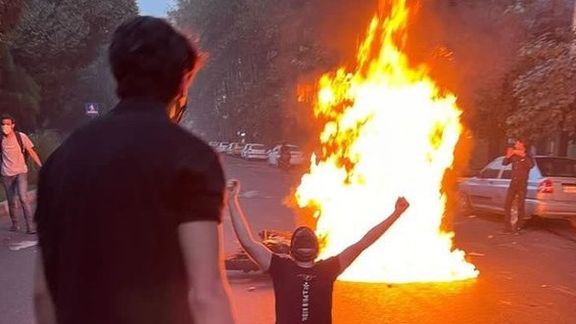Iranian Teachers, Students Plan Another Major Strike For Tuesday

Iranian teachers have issued a statement announcing a nationwide strike by teachers and students to "show their solidarity and support with all the protesters.”

Iranian teachers have issued a statement announcing a nationwide strike by teachers and students to "show their solidarity and support with all the protesters.”
The Coordination Council of Iranian Teachers’ Trade Associations called on all teachers and students to refuse to attend classes on Tuesday, October 4. The teachers’ union was among the first to start nationwide strikes in support of the current protests, ignited by the murder of 22-year-old Mahsa Amini in custody of hijab police.
In the statement, the council referred to huge protests by different social groups for justice and their rights, saying "Many of these protestors are students who, along with millions of other Iranians, are fed up with the existing unbearable suffocation."
It also called on the military and law enforcement forces to stand behind the people so that in the near future they would not regret it before a “people's court".
As the protests in Iran entered its third week, an organized violent government attack on protesting students in Tehran’s Sharif University Sunday has heightened tensions in Iran that can lead to more unrest.
The university’s Islamic Student Association Monday issued a call for a general, national student strike and early reports and images already show protests in many universities including in Esfahan, Mashhad, Sanandaj, Semnan and Kermanshah.
While Iran’s ruler Ali Khamenei was delivering a speech Monday dismissing nationwide protests, students in a dozen universities began rallying against his regime.

Germany, France, Denmark, Spain, Italy and the Czech Republic have submitted 16 proposals for new measures by the European Union against Iran over its violent clampdown on current protests.
A German foreign ministry source said on Monday that the new sanctions would target people and institutions primarily responsible for the Islamic Republic’s crackdown on Iranian protest, ignited by the death of 22-year-old Mahsa Amini while in custody of hijab police.
The EU foreign ministers are set to decide on the measures at their meeting on October 17, with no resistance expected from the members of the bloc, Spiegel magazine reported. "We are now working flat out to implement these proposals," the source said.
Promising to sanction Tehran over its bloody crackdown, German Foreign Minister Annalena Baerbock said on Monday that Iran's suppression of protests was "an expression of sheer fear of education and the power of freedom,” referring to the organized violent government attacks on protesting students in Tehran’s Sharif University Sunday night.
"It is also difficult to bear that our foreign policy options are limited. But we can amplify their voice, create publicity, bring charges and sanction. And that we are doing," she tweeted.
The university’s Islamic Student Association Monday issued a call for a general, national student strike and early reports and images already show protests in many universities including in Esfahan, Mashhad, Sanandaj, Semnan and Kermanshah.

Iran's exiled Prince Reza Pahlavi has called US President Joe Biden not to enter an agreement with Tehran that would financially benefit the Islamic Republic’s repression machine.
In a tweet, he said that the Islamic Republic is firing on students at Tehran’s Sharif University of Technology, “yet reports indicate the US may send this criminal regime billions yet again.”
Sunday night, an organized violent government attack on protesting students in Tehran’s Sharif University heightened tensions in Iran that can lead to more unrest. After the fog of battle cleared Monday morning, the extent of what security forces planned and executed in Sharif University became clear. The emerging picture shows maneuvers and deception by security forces to corner the students and beat and arrest many.
Addressing President Biden, he said that “you have yet to help our people. At least don't fund the bullets piercing the hearts of our youth!”
Earlier in the day, Pahlavi had urged the US and other Western nations to do more than provide “moral support,” saying that “As Iranian workers strike to protest and cripple this regime, the West can support them by facilitating the creation and administration of strike funds for their families.”
The latest round of nationwide protests in Iran appears to be different from the protests that have rocked the Islamic Republic since 2017 in more than one way.
The protests, sparked in Tehran late evening on September 16 following the death in custody of Mahsa Amini, 22, are dominated by women and youth yearning for freedom and equality.

State media quoted Iran’s ruler Ali Khamenei as saying that protests were planned and not staged by "ordinary Iranians", in his first reaction to ongoing unrest.
Khamenei’s reaction calling protesters “rioters” and praising security forces are similar to his comments about anti-government protests in the past, such as in January 2017 and November 2019, when security forces killed at least 1,500 people.
The aging 83-year-old Khamenei who has ruled for 33 years, said, “I am saying explicitly and clearly, riots and insecurity was planned by America and the usurper, fake Zionist regime.”
In fact, protests began in mid-September after a 22-year-old woman, Mahsa Amini was killed by heavy blows to her head while in the custody of hijab police. Her death first led to protests in her native Kurdish region of western Iran and then reached the capital Tehran and other cities two days later.
As happens often in Iran, officials tried to portray her death as the result of illness, and no one has been held responsible after the initial incident on September 13.
Khamenei’s reported appearance Monday at a ceremony came after his two-week total absence from the scene that had led to speculations about his health. He had been reported to be unwell even before the protests.
Although state media extensively quoted Khamenei and published a few photos of the ceremony, no video was released, which could have presented a more solid proof of his health status.
Before his appearance on Monday, some activists on social media were commenting that Khamenei’s supporters might be wondering where their leader is. But Iran’s ruler in the past has often waited to see if his forces are on the verge of victory before showing up and condemning the protests. This time he apparently could not wait any longer.
Protests in nearly 100 cities and towns in the past two weeks have been met with violence by security forces and 133 protesters have been confirmed dead by a human rights group, but so far, the government has not used overwhelming military force to kill demonstrators.
Most of the anger during the protests has been directed at Khamenei himself, with frequent chants of “Death to the dictator” and “Death to Khamenei”. He is seen as presiding over a pyramid of repression by clerics and the loyal Revolutionary Guard, with endemic corruption everywhere in the government.
Khamenei on Monday also praised security forces and cadres loyal to him, although he also pretended that the Iranian people oppose what he described as a conspiracy to foment protests. He also repeated unfounded allegations by his loyalists that protesters “burned Qurans”, forced women to take off their hijab and attacked mosques.
Khamenei also said that Mahsa Amini’s death was an excuse and even if she had not died “they would have created another excuse…to sow insecurity in the country.”
While the United States and many other countries have condemned Mahsa Amini’s death as well as discrimination and violence against women in Iran, Khamenei dismissed the criticism. He also dismissed US statements that Washington has no intention of attacking Iran or changing the regime.
“Plotting and actions by the enemies show their real self. The same enemy that in diplomatic remarks says we have no intention to attack Iran or to change its regime…pursue plots to create riots,” Khamenei said.

An organized violent government attack on protesting students in Tehran’s Sharif University Sunday has heightened tensions in Iran that can lead to more unrest.
After the fog of battle cleared Monday morning, the extent of what security forces planned and executed in Sharif University became clear. The emerging picture shows maneuvers and deception by security forces to corner the students and beat and arrest many.
The university’s Islamic Student Association Monday issued a call for a general, national student strike and early reports and images already show protests in many universities including in Esfahan, Mashhad, Sanandaj, Semnan and Kermanshah.
After more than two weeks of unrest, Iran’s hard-liners loyal to Supreme Leader Ali Khamenei, who is often the target of derogatory slogans by protesters, are simply caught in a typical ‘no-win’ situation. The more they crack down, the more anger will grip young people who drive and lead the protests. And if they show little reaction, crowds will become more emboldened and perhaps march on government buildings.
Sharif University students had gathered Sunday morning inside the main gate chanting slogans when a group of pro-government Basij militants showed up and taunted them. Student slogans became more radical to the degree of profanities against Khamenei, who is the favorite target of protesters.
At this point students decided to relocate to another gate, because they knew that cameras were installed at the main gate which could be used to identify them. Once they reach the new location; they see that security forces were waiting for them right outside the campus in the surrounding streets. Security forces start firing shotgun pellets and paintball guns at the students and arrest and injure several.
At this point university officials shut the gates not to allow security forces inside the campus, which is prohibited by law. University officials and guards tell the students to exit the campus through a multi-story parking. Once student reach the first and second levels of the parking, they find themselves surrounded by plainclothes armed vigilantes, who start firing shotgun pellets and tear gas at the students. At that point students began running at all directions. The agents arrested around 30-40 students, whose fate remains unknown.
Student retreat inside the buildings with no way to leave the campus as hundreds of security forces had surrounded the university. These events took hours until finally at night the minister of higher education Mohammad Ali Zolfigol arrives to defuse the situation. He gets into an argument with security forces asking them to allow the students to leave the campus unharmed.
After that the minister meets with the students in an auditorium where he admonishes them and by some accounts insults a professor who was all along trying to defend the students. Finally, late at night students agree to leave the campus after promises of safe passage, but some reports say security forces make more arrests. In total, unconfirmed reports speak of 100 students having been detained and sent to an unknown location.
Iranian universities have been the bastion of opposition throughout Iran’s recent history, and many have been killed during protests by security forces. Once university students are galvanized it would be hard to subdue them and a new generation opposition activists will emerge.

While assessments by Iran’s intelligence and security organs show serious dissatisfaction among young people, they still call for a harsh response to protests.
Revolutionary Guard (IRGC) mouthpiece Javan newspaper acknowledged in an October 1 report that "based on demographic intelligence about the protests, over 93 percent of those taking part are young men and women below the age of 25." The IRGC called them "a younger generation of rebels."
Meanwhile, this assessment has revealed that despite gender segregation rules that strictly separate young men and women, some 90 percent of protesters join the rallies as "couples".
Earlier, the IRGC-linked Fars news agency had also reported that protesters are "young adults who are not committed to religious values."
On October 2, IRGC Commander Hossein Salami also admitted that a new generation of protesters has taken to the streets of Tehran and other Iranian cities during the past two weeks. Meanwhile, he acknowledged that young Iranians "are not interested in the IRGC" and what it does. Nonetheless, he said: "We defend everyone even those who do not like us." However, the Guards were not seen defending anyone during the past weeks and also in previous rounds of protests. Instead, Iranians have seen them using violence against protesters.
During the past two days, Salami has threatened "to take revenge" from the people in Baluchistan province where tens of locals were killed by the IRGC on September 30 and its intelligence chief in the province was allegedly killed by protestors on the same day. The hard-line Parliament (Majles) has also called on the IRGC to take revenge for the protests.
Meanwhile, an Intelligence Ministry report repeated typical rhetoric that the British and Saudis as well as other countries are involved in the protests behind the scenes. The report said that intelligence officers accompanied the police and Basij militia in the suppression of the protests and gathered intelligence about the organizers and supporters of the protest movement.
The Intelligence Ministry claimed that it has arrested 92 monarchists, 49 members of the Mojahedin-e Khalq (MeK) organization as well as 77 members of militant Kudish parties on both sides of the Iran-Iraq border.
The Ministry also claimed that it has arrested five members of an un-named Takfiri group who were in possession of 36 kilograms of explosives. The group, the ministry claimed had plans to assassinate a state official and bomb religious centers in Mashhad and Shiraz.
In an interesting but otherwise unproven claim, the Ministry of Intelligence said it has arrested 9 German, Polish, Italian, French, Dutch and Swedish citizens in or behind the scenes of the protests. The ministry said that it has issued warnings to a number of foreign countries' embassies in Tehran. However, there are no independent confirmation of the alleged arrests and warnings.
Responding to these claims, Paris based Muslim scholar Mohammad Javad Akbarin wrote in a In an October 2 tweet: "The Iranian government has blamed "Citizens of Germany, Poland, Italy, France, Holland, Sweden, as well as Bahais, the Mojahedin-e Khalq (MeK), the Pahlavi dynasty and others" as those who have conspired to bring about protests in Iran. Yes! It is only this ugly government that is good!"
Meanwhile, reformist commentator Abbas Abdi also responded to the ministry's claim, saying that, "Iranian hard-liner neo-conservatives reactions to the protests that followed the death of Mahsa Amini reveals nothing but their ignorance, sorry state and weakness.” Abdi further charged that the current protest and those in 2018 and 2019 are the outcome of provocations made by hard-liners.
Abdi noted that they never assume any responsibility for what they have done and do not want to be accountable for their own behavior, which is the underlying cause of dissent and protest, and instead, they blame others for their own actions.